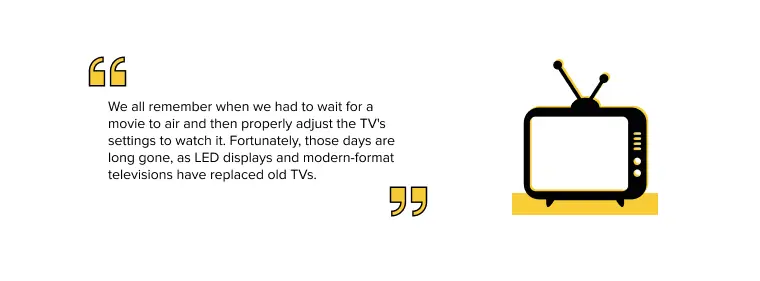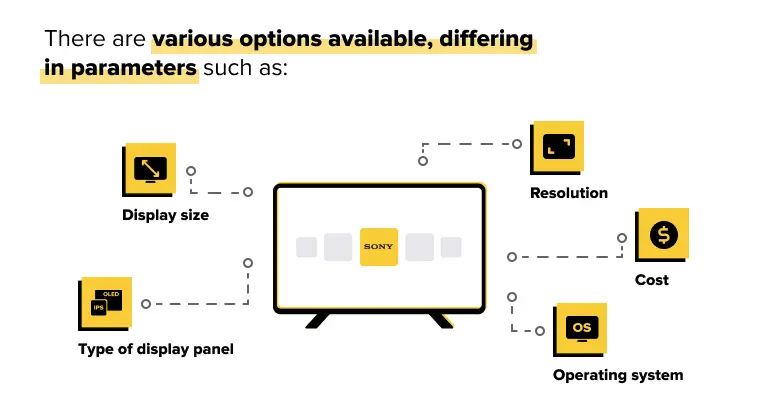Everyone consumes digital content. Some people consume more, while others limit themselves to browsing social media or watching their favorite TV shows. What unites them is their interest in using technologies that provide access to visual content.

The Smart TV industry today could rival the GDP of a small country. According to Spherical Insights, the global market size was already $190 billion in 2021. And predictions show that the segment's Compound Annual Growth Rate (CAGR) will remain at 11% until 2030, reaching a value of $450 billion.
This indicates the growth potential of the Smart TV industry and the opportunities for those who want to venture into this market with their own ideas or concepts.
The experts at Lampa Software have prepared a piece where they talk about:
Sony Smart TV app development and the peculiarities of the process.
Important nuances, such as customization and integration.
The possibilities of open-source OS and its adaptability to live streaming.
Various ways of monetizing broadcasting or OTT platforms.
The key advantages of developing such a solution.
What is Sony Smart TV
In simple terms, Sony is a Japanese brand specializing in electronics, including photo and video equipment, smartphones, and other semiconductor products, such as Smart TVs.
Unlike other major players in the market, the company focuses on hardware development, integrating ready-made IT solutions into its devices. In the case of Smart TVs, this involves using Android and its specialized version, Google TV (a fork rather than just a program).
The Evolution of Smart TVs: From Traditional to Smart
Sony's history as a television manufacturer dates back to the days of tubes, external antennas, and black-and-white films. Back then, the market was saturated with offerings from well-known brands that had little to differentiate them from one another.
At the beginning of the 2000s, the industry underwent some transformation, offering digital pictures and a few different user interfaces to reach a broader audience. However, this period was relatively stable and quite lengthy.
The first conceptual Smart TV solution is considered to be Sony Qualia 005 (demo, 2004), a television that could connect to the Internet. But it was just a trial run, and the idea became widespread only after 2010.
As of 2023, all key electronics manufacturers offer several Smart TV options in their product lineup, and they continue to develop them further. This development primarily involves modifications to the platform and support for third-party digital solutions like streaming apps.
Sony's Smart TV Ecosystem: Features and Capabilities
Among Sony's Smart TV lineup, you can find a variety of televisions, from universal ones to niche models. While some offer top-of-the-line OLED displays and over 200 centimeters of screen width for consuming digital content, others focus on a higher refresh rate (120GHz), which is optimal for gaming.
There are various options available, differing in parameters such as:

But they all share one common feature – the "Smart" designation, meaning the TV can run third-party apps developed by app developers. And this greatly expands the device's capabilities.
The Role of Apps in Enhancing Smart TV Functionality
While it may not be possible to change the interface and navigation of Smart TV apps, adding streaming platforms, browsers, or other programs is entirely feasible.
This means that users will have alternatives for consuming content. As an entrepreneur implementing such software, your task is to make these alternatives more appealing to your target audience than your competitors' solutions. The experts at Lampa Software can help you with that.
The Importance of App Development for Sony Smart TVs
Users rarely limit themselves to the built-in capabilities of their Smart TVs, especially since the target audience of these devices consists of millennials and zoomers – relatively progressive generations accustomed to maximizing the potential of their technological solutions.
You can reap maximum benefits by developing your digital product for Sony Smart TVs, but only if you're not afraid to deploy a feature-rich and modern app.
Enhancing User Experience: Personalization and Convenience
User experience (UX) is all about how users interact with your application – the logic of navigation, interface design, aesthetics, performance, and personalization options. This entire package is crucial in how potential audiences perceive your digital product. It's the key to success in your target market.
Expanding Content Options: Access to Streaming Services and Beyond
What your audience wants to see, what content interests them, and whether they are willing to pay for additional features – the answers to these questions will lay the foundation for coding your future application. Regardless of your initial focus, you can implement additional functionality as the software evolves.
Driving Customer Engagement and Loyalty
Development is not one-sided; it involves constant communication with your target audience. By aligning with the desires and needs of potential customers, you can better structure your software and offer them a unique solution that will become a favorite among most Sony Smart TV owners.
Behind the Scenes: Sony Smart TV App Development Process
Not all applications are created using Smart View SDK, and not all of their functionalities should be copied from the most successful IT solutions in the industry. The market is going through challenging times in terms of software variability. To win the race for a share of this segment, you should diversify your product and make it multilingual. But that's not all.
Ideation and Conceptualization: Identifying User Needs and Trends
Do you know why open-source solutions are gaining popularity so rapidly? Because they are developed according to the interests and desires of users. Whether the product is based on HTML or hypothetical React Native, it doesn't matter as long as it meets the target audience's needs.
Before diving into development, it's essential to discover the prevailing trends in the market and understand how users perceive current IT solutions – what they like and what turns them off.
Design and User Interface: Creating an Intuitive and Visually Appealing Experience
How do people typically interact with Smart TVs? Through remote controls or in expensive versions with gestures or touch screens. Therefore, it's crucial to provide your application with UI and navigation methods that work seamlessly across all platforms. This creates the level of user experience that influences the audience's loyalty and preference for your application.
Development and Integration: Building Robust and Scalable Applications
The technology behind the software, whether it's HTML5, hypothetical Flutter, or even a native Linux core, isn't the most crucial aspect. The key is ensuring the platform's capabilities are sufficient for launching the IT product and its future development and scalability.
Testing and Quality Assurance: Ensuring Seamless Performance Across Devices
Considering the platform's specifics and Sony's wide range of devices, it's essential to ensure that the application is compatible with all of them. Additionally, thorough testing for performance, adaptability, and various other metrics is crucial. This will help you better understand your software's potential and focus on its improvement.
Deployment and Maintenance: Continuous Updates and Improvements
Release it and forget about it? That's not how it works, especially if you want to monetize your application. In any case, you must maintain your IT product and expand its capabilities. In the long run, this will enable you to migrate the software to newer platforms.
Overcoming Challenges in Sony Smart TV App Development
Just like with any other type of development, creating software for Smart TVs poses numerous challenges. The experts at Lampa Software have put together a brief overview of some of these challenges and recommendations for mitigating potential issues.
Compatibility and Fragmentation Issues: Dealing With Diverse Platforms and Screen Sizes
Different TV models mean different technical specifications, screen sizes, resolutions, and processing power. Adapting your software for all devices simultaneously can be expensive and inefficient, considering the current number of models.
To save some resources, we recommend focusing on TVs that will remain relevant for at least the next 2 years, which would be the 2021 and newer model ranges.
User Interface and Remote Control Limitations: Simplifying Navigation and Interaction
Smart TV program interfaces typically have a somewhat convoluted structure that solely considers navigation through remote control, making it even more complex. However, most modern devices support Bluetooth and Wi-Fi, so why not take advantage of that?
For instance, you can implement an additional mini mobile app or a smartwatch app that allows users to control their TV more comfortably.
Security and Privacy Concerns: Safeguarding User Data and Preventing Vulnerabilities
Smart TVs are generally less appealing to hackers and less susceptible to breaches. However, it's crucial not to overlook other risks, such as the interception of payment or confidential user data during subscription transactions or other actions.
Focus on protecting users' personal and financial information by implementing multi-factor authentication, data transmission encryption, and other security measures.
The Future of Sony Smart TV App Development
And finally, towards the end of the material, we invite you to let your imagination roam and explore the industry's future. Specifically, to analyze trends and make subjective short- and long-term forecasts.
Integrating Emerging Technologies: AI, Voice Recognition, and IoT
Sony TV app development may seem archaic in terms of technology usage, but the truth is, there's fantastic potential here. Just imagine, in the next 5-10 years, integrating something like ChatGPT or Bard into your app. Add voice control capabilities (which are already actively being implemented) and synchronization with various Smart Home ecosystem devices.
Bright prospects, right?
Enhanced Cross-Platform Compatibility: Seamlessly Connecting Smart TVs With Mobile Devices
Currently, it's possible to synchronize smartphones or smartwatches with Smart TVs, but it's not quite the level of interaction that your app could potentially achieve. Device control, rapid content sharing, social viewing rooms, and many other features await the industry in the next decade.
Augmented and virtual reality experiences: Transforming entertainment in the living room
The WWDC 2023 exhibition showed us the key trend for the next decade. Apple's emphasis on its "innovative" Vision Pro was no coincidence. Combined with your Smart TV-based app, this headset can immerse users in virtual environments and take the UX to a new level.
Conclusion
Ten years ago, the essence of IT solutions for Smart TVs was limited to web browsing or ad-free movie watching. But now, their range of applications has significantly expanded, along with monetization possibilities. You can choose the best model for your app: free access with ads, subscription, one-time purchase, and more.
Considering experts' forecasts of an increased market share for Smart TVs, there's a great potential to integrate into this niche through applications, with long-term prospects (at least until 2030). So, we can expect to see many new digital products for these devices very soon.
Do you want to lag behind in the race for trendsetting positions in this segment? If not, contact the Lampa Software manager and describe your idea. With the help of our team of experts, you'll quickly make your debut in the market and secure a worthy position in the Smart TV digital product rankings.